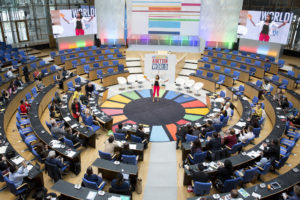Global Festival of Ideas (GFI) held in Bonn Germany write-up to help answer this question.

There are 17 Sustainable Development Goals (SDGs) to be achieved by 2030. The inter-sectoral links between the goals add complexity in our approach to reach them. A siloed and ‘one size fits all approach’ will have limited – if any, success. This is because the SDGs cross research disciplines and are context specific. The question is how could technology contribute to the SDGs? So I signed up to attend the Global Festival of Ideas (GFI) held in Bonn Germany earlier this month to find out more.
The GFI was the first in a series of annual forums, hosted by the UN SDG Action Campaign, supported by the Federal Government of Germany and other partners. It aimed to explore ‘a new way of thinking about how we achieve the SDGs’ through plenaries, games, policy simulations and fishbowl conversations.
Each day focused on a theme – Inequality, Sustainable Growth and Disruptors (full agenda) asking the following questions:
- How can we challenge inequality and exclusion in a rapidly globalising world?
- How can we promote economic growth and prosperity with environmental sustainability?
- How can we protect individuals and communities caught up in shocks and disruptors?
The festival was also the world’s first “playable” policy conference, bringing together leading thinkers, policy-makers and members of civil society, with gaming experts and policy simulators.
What is a playable conference?
The organisers developed a game – HIVE 2030. The game was a way to explore how the SDGs are linked. What was great about the game was that some policies contributed to a SDG positively or negatively. For example, I was allocated SDG 14 – Life under water. For example, one policy in my ‘policy deck’ focused on increasing the agricultural yield. This was detrimental to my goal but beneficial to several others. This would mean I would have to work out how much of my budget I would give to the goal (if at all) as it would help achieve other goals. Throughout the conference there were ‘news’ bulletins with world or regional news that would affect the game – bringing home the idea that policymakers have to be responsive as well as focusing on long term goals.
It is easy to forget that the SDGs apply to every country – it is not just something that only affects developing countries. The activities at the conference helped bring the SDGs to life.
The role of technology
One of my highlights was viewing the 360 degree content at the UN Virtual Reality zone. I immersed myself into Sidra’s life – a young girl who lived the Zaatari Refugee camp which really bought to life the realities of camp life.
I think Virtual Reality (VR) is a brilliant empathetic tool that helps people to understand how other people live and how people are affected by complex development challenges. However, it is important to be cautious about the role of technology when it comes to SDGs. Just because something is cool and new does not necessarily mean it is appropriate to employ to solve every problem. It is important to appreciate different technologies’ limitations to employ them effectively.
It will be interesting to follow the role of technology as time goes on. At the festival, there was a definite wariness about the role of technology and it could exacerbate inequality – for example, the cost of technology can be so high it limits who can use it. Another question worth considering is how much access firms and governments have to our personal data? Is this a good or bad thing?
In my opinion, it is not really technology itself that is ‘good or bad’ but rather the motivation of providers and users. Technology can help us understand development challenges through improved data collection and storytelling for example – but also provide us with new ways – such as Hackathons, to tackle them.
And lastly
It is important to note that the SDGs are not legally binding. It is up to us to hold our governments to account to develop frameworks to reach them. Christian Kroll (Scientific Co-Director of SDGindex and Bertelsmann Stiftung Foundation) summed it up well when he said “The SDGs are like keeping New Year resolutions – there needs to be goodwill and support in achieving them.” I have to say that I agree with him – do you?
Image credit: Meagan Carsience via Unsplash
